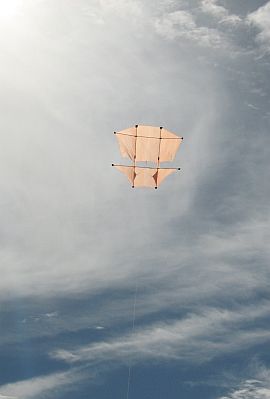- Home Page
- Flight Reports
- Sticked Doperos
- 2-Skewer Dopero
2-Skewer Dopero Kite
Gusty Fresh Winds Spring Up From Nowhere
Winds around the house were moderate and gusty in the morning but were nothing that the trusty 2-Skewer Dopero kite couldn't handle. Besides, there was a chance the breezes would die down further toward the midafternoon when we planned to fly.
 MBK 2-Skewer Dopero
MBK 2-Skewer DoperoSure enough, the weather seemed very calm as we pulled up at the only decent-sized local reserve that wasn't weed infested. The prickly kinds of weeds we have around here have a habit of catching the flying line, not to mention parts of the kite and its bridle.
After placing the wind meter on the grass, some seconds passed before the little cups even started to spin! No problem, the 2-Skewer Dopero kite has a track record of doing very well in light winds—even no wind at all if some thermals are about!
A few meters of line were let out to get the kite up for some photos. The small dopero hovered and climbed slowly in the soft puffs coming through while I worked the line a bit as well.
Perhaps ten minutes later, fresh gusts started rolling across the reserve. It was very sudden, most unexpected, and somewhat unwelcome! This wind was possibly associated with the Adelaide Hills only a few kilometers to the east. We get gusty "gully winds" sometimes.
All of a sudden, the dopero was straining at the leash, zipping around left, right, and almost overhead. While still on 20 meters (70 feet) of line, some photos were taken. It's hard to get a sharp inflight picture when the kite is hundreds of feet up.
The flying could be called uncomfortable, with the kite being forced into large loops from time to time and generally being battered by the wind.
On this site, there's more kite-making info than you can poke a stick at. :-) Want to know the most convenient way of using it all?
The Big MBK E-book Bundle is a collection of downloads—printable PDF files which provide step-by-step instructions for many kites large and small.
That's every kite in every MBK series.
A few times, I brought the kite down and tweaked the upper bridle loop knot left or right. This kite is quite sensitive to the knot position, so I overshot once or twice!
There were some problems with old tape giving way as well. Most of the spar caps were originals from the day the 2-Skewer Dopero kite was made in November 2008! They do a good job generally but don't last forever.
As usual, I had come prepared with a roll of yellow insulation tape in a shorts pocket. Over the next half an hour or so I ended up replacing or reinforcing most of the spar caps, trying not to add too much unnecessary weight, of course.
My young son Aren got sent over to the wind meter on an errand—to push the reset button! Otherwise, the average might be a bit low due to the earlier calm conditions.
Quickly, the kite line went out to 30 then 60 meters (200 feet). Even so, it was still necessary to bring the dopero down for another bridle adjustment. It was still hanging to the right in the now smoother but still rather fresh breeze up there.
Although the 2-Skewer Dopero kite was pulling very firmly, I thought Aren might like to test his muscles on it, so I gave him the line. Nearly 5 years old, he's getting stronger all the time. Aren boasted that the kite wasn't pulling very hard at all.
After edging back toward the eastern boundary of the reserve, there was room to let out all 120 meters (400 feet) of line. At this length, and due to wind strength being higher than optimum, probably, the 2-Skewer Dopero kite refused to go much higher than a 50-degree line angle. Never mind, at least it's having a good high fly! Also, I hadn't thought to shift the towing point forward at all. So the kite was still on its light-wind setting!
After taking down the kite one last time, we had the trim pretty close to perfect. But time was running out, and it was decided not to loft it up on the maximum line-length again. Plus both upper sail tethers were starting to pull through due to the unrelenting wind strength. In fact, in the photo up there you can see that the left panel has gone a bit loose. That wouldn't have helped the trimming problems!
Most reports on the 2-Skewer Dopero kite have focused on its great light-wind performance.
However, today was a day for exploring the upper end of this kite's wind range. If you have made a 2-Skewer Dopero, be persistent with making tiny adjustments to the upper bridle loop knot. The kite will fly straight as a die when you get it right, even in a fresh breeze.
During packing things up, I noticed from the Windtronic 2 anemometer that the wind speed had averaged 7.4 kph at ground level, gusting to 23 kph. Perhaps that was closer to 35 kph up high, judging by the bent-over upper branches of the trees during the strongest gusts! Plus there was heaps of leaf noise.
The story or stories above document actual flying experiences. My write-ups are definitely "warts and all," since things don't always go totally as planned. However, half the fun of kiting is anticipating the perfect flight. When it happens, it's magic!
As mentioned earlier, there's more kite-making info here than you can poke a stick at. :-)
Want to know the most convenient way of using it all?
The Big MBK E-book Bundle is a collection of downloads—printable PDF files which provide step-by-step instructions for many kites large and small.
That's every kite in every MBK series.
